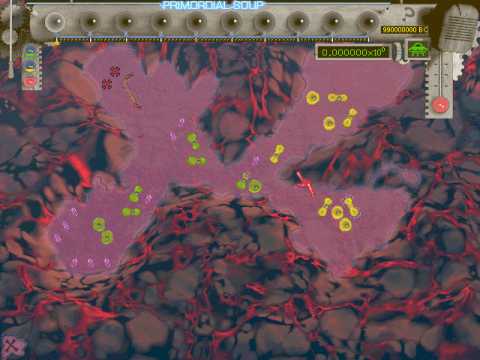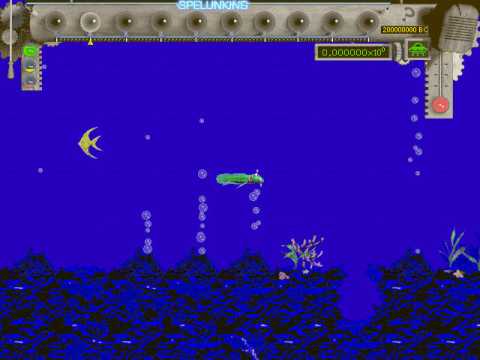The Premise
Like any adventure in the series, the story begins with Dr. Brain devising a plan to perform a mundane task using supernatural technology. In this case, he builds himself a time machine with the purpose of figuring out where he left his car keys. Unfortunately (and expectably), he does not manage to go a few hours into the past but instead is flung far and wide across the entire space-time continuum, stopping at particular time periods to observe events and to collect something so he can make his way back to the present--the game never directly addresses this point so one can only guess what that something might be. Regardless, if Dr. Brain's helpful assistant (You) can complete the puzzles from each time zone Dr. Brain travels to, he will have what he needs to travel back to the present...whatever that happens to be.
The Stops
The game/puzzle element of the Time Warp of Dr. Brain is a collection of mini-games that have the player completing tasks intelligently and, in a few cases, rapidly to succeed. Each mini-game takes place at a specific point in the timeline of existence and is themed accordingly, though not without anachronisms (see Caveman Rock). The puzzles are built around exercising particular areas of brain (as Dr. Brain is keen to tell you during the course of the game) and as a result the difficulty curve is structured with kids in mind, but if you ramp the difficulty from Novice to Expert or Genius the experience becomes more than difficult enough for an adult.
 The war to start all wars.Primordial Soup - 990,000,000 BC
The war to start all wars.Primordial Soup - 990,000,000 BC
A simplified real-time strategy game at heart, Primordial Soup charges you with the task of commanding an army of green cells through primordial ooze to defeat an opposing army of yellow cells. There are several elements to pay attention to during the fight which increase in frequency and relevance as you advance. These elements range from food (splits a cell into two) to bacteria (eats food) to viruses (infects and weakens cells and then multiplies when the cell dies) to protozoa (just moving obstacles). The game is very simple but there are a number of odd strategies that can be fleshed out of dominance of territory and, particularly, the dissemination of viral outbreaks in ways that block in your opponent.
 Just hold your breath.
Just hold your breath.
Spelunking - 200,000,000 BC
In this adventure/platformer/not-really-either-of-those-things you assume the role of a lungfish spelunking in a cavernous bed of water with intent of making it from where you are to...where you're going. To do this, the player navigates these vertical aquatic caves avoiding predatory fish and gathering air from bubbles issuing from ground deposits. The only danger to the lungfish is running out of air and this is tracked by the color of the lungfish on screen: green is good, purple is bad. The maps are very maze-like and finding your way through is not always straightforward, but as long as you have a pocket of air or a geyser nearby, you will be okay.
 Triassic hot potato.Lizards and Eggs - 60,000,000 BC
Triassic hot potato.Lizards and Eggs - 60,000,000 BC
Lizards and Eggs has the player assume the role of a lizard attempting to raise eggs into baby lizards by placing the eggs on top of geysers to keep them warm. A red geyser indicates warmth and blue cold. These geysers change in color frequently in an extended pattern that must be watched to make sure the eggs stay warm for long enough to hatch. In order to win, all of the eggs in play at the beginning of the game must hatch. None of them are allowed to freeze over, which is where the game becomes an exercise in rapid evaluation and prioritizing. You have to gauge whether it is worth waiting an extra second for an egg to hatch, giving you one less thing to worry about, or saving an egg that is nearly frozen over. Multiply this evaluation by 3 or 4 at time, repeat it in succession, and you get this mini-game.
 The natural engineer.Beaver Dam - 2,000,000 BC
The natural engineer.Beaver Dam - 2,000,000 BC
In this mini-game, you are a beaver trying to dam a river with clumps of sticks that drift past you from upstream. The player moves the beaver around in the water who in turn pushes objects away from him. Using this ability, the player must successfully connect clumps of sticks to each other until they reach across the entire river in a line. Sticks already in place can be reinforced with more sticks with the benefit that logs (also flowing downstream) do not dislodge any sticks already connected to the node. Several obstacles thwart your progress toward a complete dam. Turtles show up from downstream and repulse objects the same way you do; more annoying than problematic. However, electric eels may show up and send your beaver flailing wildly for a few seconds and occasionally land animals will sabotage your dam from the shore and must be shooed away before they destroy it.
 A Stone Age Rock Band.Caveman Rock - 1,000,000 BC
A Stone Age Rock Band.Caveman Rock - 1,000,000 BC
"These funky fresh cats have their first gig tonight and they still haven't learned their parts!" explains Dr. Brain as the opening to the ubiquitous music mini-game in the set. For each puzzle, the player must construct a melody from a recording using blocks with caveman writing on them. Each of these blocks contains a sound byte from the recorded melody and must be placed in sequence on the bone row to exactly imitate the melody. You are assigned one of the four performers (durmmer, guitarist, bassist, and accordion harmonica man) for each melody unless you play on Expert or Genius, in which case it can be multiple. The hardest part of this mini-game is the lack of hints. If you screw up on the melody, the game gives you no indication of where you screwed up, forcing you to go through the melody again and again until you find the error. This can be very tedious in the longer pieces.
 Prove that you were naturally selected.Monkey See Monkey Do - 10,000 BC
Prove that you were naturally selected.Monkey See Monkey Do - 10,000 BC
This hybrid of Scrabble and a word search pits you, the stone age human, against a monkey (who appears to actually be an ape) in struggle to create as many three, four, and five letter words as possible. You do this by placing letters one at a time from a bank on the board. You take turns placing letters with the monkey, forming words with said letters, until the stone scale in the background leans far enough to one side. This mini-game is the most affected by difficulty level because it implements sign language by varying degrees at each difficulty level. On Novice, though you can't actually see the monkey's bank of letters, he will make his next letter out in sign language. On Expert, your bank of letters is in sign language. On Genius, the whole board is in sign language. If you do not take strides to learn sign language, the game cannot be played reasonably on anything but Novice. Thankfully, you might learn it playing on Novice if you pay attention because your character will sign your letters as well.
 Chemistry made medieval.Alchemy - 1400 AD
Chemistry made medieval.Alchemy - 1400 AD
Though the prospect of turning base metals into gold fell flat, the science of turning one weird chemical into another weird chemical lives on in this puzzle which essentially like doing abstract algebra. You begin with a chemical and are tasked with duplicating the chemical on the desk by changing your chemical's volume, color, tone, and temperature. You must use a machine made of the finest discarded junk to change your chemicals properties; this machine has four passages that you can send your chemical through, each affecting its properties as described on the front of the desk. After enough fiddling (or, if you want, planning) you will either reach the desired state or you will bring one of the properties of your chemical past the allowed extremes at which point it turns into useless sludge and you have to start over.
 Rush hour is not a thing of the past.Gridlock - 5000 AD
Rush hour is not a thing of the past.Gridlock - 5000 AD
Logistics is the alpha and omega of this puzzle. There are a number of hovercars that need to get to their respective hoverpads without colliding with each other or any ice cream trucks, garbage trucks, or steamrollers that happen to be passing by. You required to program the cars based on their color at each junction in the roads to get them safely back home. If your timing is good and redundant programming does not cause your vehicles to go in endless circles, you win. There are many curveballs to these puzzles, the most common being multiple cars of the color. Minimal programming is key in these situations as only one car is allowed on a single hoverpad, so if two cars end up on the same path they both end up trying to go the same pad. The puzzles of this mini-game can be infuriating at times but they are also the most satisfying to complete successfully.
 LEGO for the 101st century.Spaceshop - 10,000 AD
LEGO for the 101st century.Spaceshop - 10,000 AD
Spaceshop is an explicit exercise in spatial organization. You are given the 3d blueprints of a "space station" that you must construct using a set of parts on the bottom on the screen. These parts can be rotated or turned in any six-axis fashion and then must be placed on a layered grid in the exact way they appear on the blueprints. Like Caveman Rock, failure does not give you any hints as to what you did wrong, but fixing it much less difficult here than in Caveman Rock. These puzzles are either very easy or very hard depending on your ability to visualize three-dimensional objects.
 Save A.I. for math problems.Brain Waves - 100,000 AD
Save A.I. for math problems.Brain Waves - 100,000 AD
This mini-game is the electronic replacement of a matrix logic puzzle book. The big brain in the middle fills you in on what he is thinking about, the brains in the tanks each have a piece of information related to the big brain's question, and the chart full of little brains is your tablet for showing conclusions you draw from the clues. The little brains go between green, red, and purple--yes, no, and not quite sure, respectively. Each clue brain has a unique voice actor from a little girl to an old Romanian to a singing woman. All of these little touches add flavor to the experience, but at heart the puzzles are 4x4 one-answer-per-row matrix logic puzzles. The difficulty level increases the number 4x4 answer squares: 1 for Novice, 2 for Expert, and 4 for Genius.
Main Menu Why wait for the game to start?
Why wait for the game to start?
The Main Menu is actually a mini-game itself. It is a Space Invaders clone involving cows, brains, clocks, and cheese. When your Dr. Brain avatar shoots down all of these bomb-dropping foes (carefully avoiding the actual menu buttons) a cheesy 8-bit fireworks parade is put on for you. There is also a plane and a UFO that fly across the top of the screen above the menu buttons. If you hit the plane, the credits roll across the top of the screen. If you hit the UFO, a high scores list from the saved games scrolls across the top.
Log in to comment